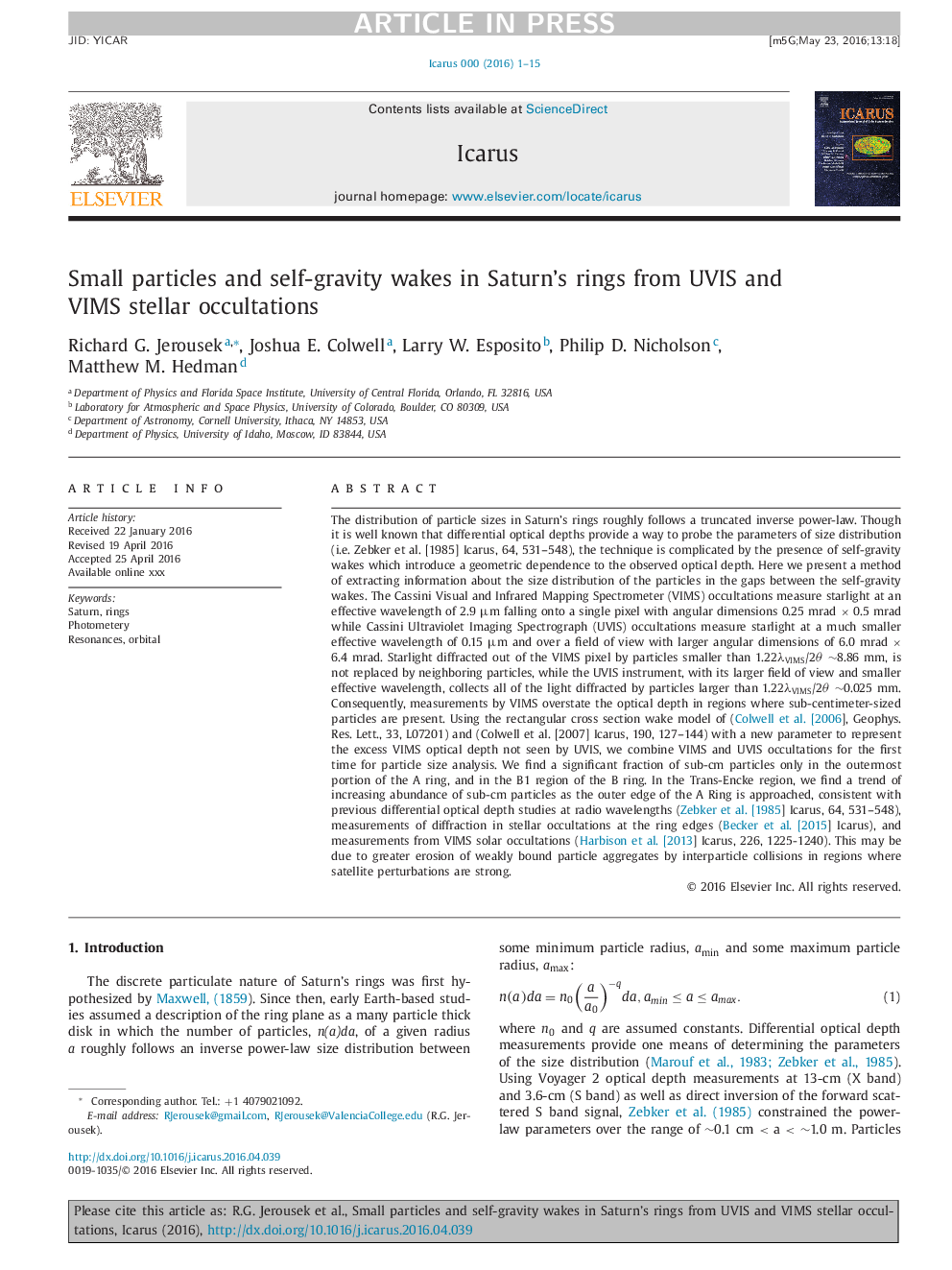| کد مقاله | کد نشریه | سال انتشار | مقاله انگلیسی | نسخه تمام متن |
|---|---|---|---|---|
| 8134740 | 1523511 | 2016 | 15 صفحه PDF | دانلود رایگان |
عنوان انگلیسی مقاله ISI
Small particles and self-gravity wakes in Saturn's rings from UVIS and VIMS stellar occultations
دانلود مقاله + سفارش ترجمه
دانلود مقاله ISI انگلیسی
رایگان برای ایرانیان
موضوعات مرتبط
مهندسی و علوم پایه
علوم زمین و سیارات
علوم فضا و نجوم
پیش نمایش صفحه اول مقاله

چکیده انگلیسی
The distribution of particle sizes in Saturn's rings roughly follows a truncated inverse power-law. Though it is well known that differential optical depths provide a way to probe the parameters of size distribution (i.e. Zebker et al. [1985] Icarus, 64, 531-548), the technique is complicated by the presence of self-gravity wakes which introduce a geometric dependence to the observed optical depth. Here we present a method of extracting information about the size distribution of the particles in the gaps between the self-gravity wakes. The Cassini Visual and Infrared Mapping Spectrometer (VIMS) occultations measure starlight at an effective wavelength of 2.9 µm falling onto a single pixel with angular dimensions 0.25 mrad à 0.5 mrad while Cassini Ultraviolet Imaging Spectrograph (UVIS) occultations measure starlight at a much smaller effective wavelength of 0.15 µm and over a field of view with larger angular dimensions of 6.0 mrad à 6.4 mrad. Starlight diffracted out of the VIMS pixel by particles smaller than 1.22λVIMS/2θ â¼8.86 mm, is not replaced by neighboring particles, while the UVIS instrument, with its larger field of view and smaller effective wavelength, collects all of the light diffracted by particles larger than 1.22λVIMS/2θ â¼0.025 mm. Consequently, measurements by VIMS overstate the optical depth in regions where sub-centimeter-sized particles are present. Using the rectangular cross section wake model of (Colwell et al. [2006], Geophys. Res. Lett., 33, L07201) and (Colwell et al. [2007] Icarus, 190, 127-144) with a new parameter to represent the excess VIMS optical depth not seen by UVIS, we combine VIMS and UVIS occultations for the first time for particle size analysis. We find a significant fraction of sub-cm particles only in the outermost portion of the A ring, and in the B1 region of the B ring. In the Trans-Encke region, we find a trend of increasing abundance of sub-cm particles as the outer edge of the A Ring is approached, consistent with previous differential optical depth studies at radio wavelengths (Zebker et al. [1985] Icarus, 64, 531-548), measurements of diffraction in stellar occultations at the ring edges (Becker et al. [2015] Icarus), and measurements from VIMS solar occultations (Harbison et al. [2013] Icarus, 226, 1225-1240). This may be due to greater erosion of weakly bound particle aggregates by interparticle collisions in regions where satellite perturbations are strong.
ناشر
Database: Elsevier - ScienceDirect (ساینس دایرکت)
Journal: Icarus - Volume 279, 15 November 2016, Pages 36-50
Journal: Icarus - Volume 279, 15 November 2016, Pages 36-50
نویسندگان
Richard G. Jerousek, Joshua E. Colwell, Larry W. Esposito, Philip D. Nicholson, Matthew M. Hedman,